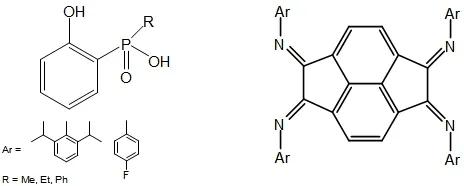Several classes of polydentate ligands seem to be promising for the development of novel SMMs/SIMs, and we initiated a project aimed at the preparation of novel transition-metal-based complexes and metal−organic frameworks supported by polyfunctional hydroxyarylphosphinic acids and redox-active (arylimino)pyracenes.
Phosphorous acids form complexes with metal atoms, which are more stable to hydrolysis compared to their carbon analogues [1]. At the same time, the presence of π-conjugated backbone allows realizing magnetic interactions between metallocentres in polynuclear complexes. In addition, the variability of possible substituents in arylphosphinic acid is particularly useful for tuning the electronic properties of resulting complexes. There are many examples of magnetically active discrete complexes and coordination polymers based on phosphinic acid derivatives but the coordination chemistry of hydroxyarylphosphinic ligands has been only scarcely studied until now.
Another class of metal complexes based on non-innocent tetrakis(arylimino)pyracene ligands opens a way for attractive fundamental research and promising applications in novel electronic, optical and spintronic devices. These ligands reversibly accept electrons and reversibly exchange them with a coordinated metal, i.e. a reversible intramolecular electron transfer between the metal center and the ligand (valence tautomerism or redox isomerism) has been evidenced in such complexes [2]. Since each electronic isomer exhibits different optical, electronic and magnetic properties, these complexes are proposed as candidates for use in molecular electronics and molecular switches. Moreover, the tetrakis(arylimino)pyracene ligands could serve as redox links for supramolecular construction, molecular wire models and metallopolymers.
[1] Shekurov et al., Dalton Trans. 2019, 48, 3601.
[2] Tezgerevska et al., Coordin. Chem. Rev. 2014, 268, 23; Fedushkin et al., Angew. Chem. Int. Ed. Engl. 2012, 51, 10584; Praneeth et al., Angew. Chem. Int. Ed. Engl. 2012, 51, 10228.
This event is supported by ESIF and MEYS
(Project FZU researchers, technical and administrative staff mobility – CZ.02.2.69/0.0/0.0/18_053/0016627)
